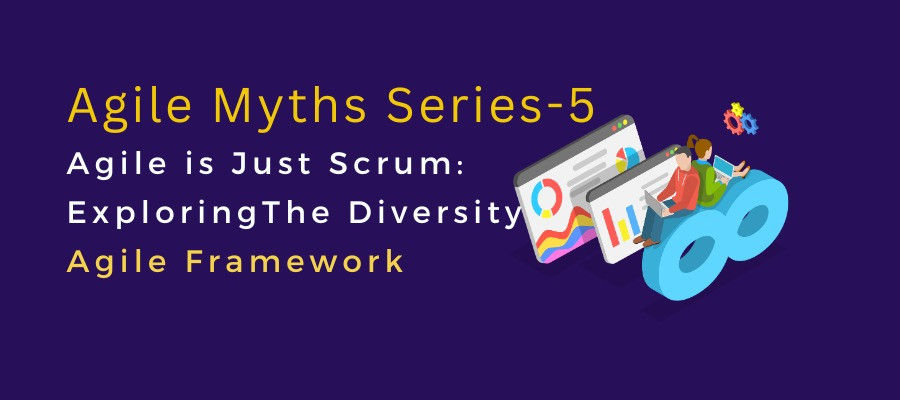Agile Myths Series 5 – Agile Is Just Scrum: Exploring The Diversity Of Agile Frameworks

How far have you been following our Agile Myths Series? We’re at the fifth post where we debunk misconceptions that Agile is synonymous with Scrum. Many consider Scrum to be the only acceptable and effective Agile framework available. However, Agile encompasses various methodologies like Kanban, XP, and Scrum to support distinct organizational needs. Today, let’s discuss the rich tapestry of Agile frameworks beyond Scrum and discover how they can benefit your Agile Teams!
Debunking The Myth: Agile Beyond Scrum
Agile is not limited to Scrum. While Scrum is one of the most widely adopted Agile frameworks, there are several other methodologies that organizations can choose based on their specific requirements:
- Kanban: This Agile Framework visualizes work and maximizes efforts while limiting work progress. It is highly effective for teams that require flexibility and continuous delivery.
- Extreme Programming: The XP Framework concerns engineering practices such as pair programming and test-driven software development. It is ideal for teams focused on high-quality software development.
- Lean Agile: This framework utilizes Lean Principles to enhance business ROI while minimizing waste. It follows a customer-centric approach that promotes continuous improvement.
- Feature-Driven Development (FDD): This framework emphasizes regularly creating tangible and working product features. FDD can support large-scale Agile projects.
- The Crystal Method: A lightweight, adaptable framework that focuses on people and their interactions over processes and tools. You can use the Crystal Method to tailor Agile Practices based on the project.
- Disciplined Agile: A process decision toolkit that provides a customizable approach, integrating various Agile and Lean strategies. It helps you tailor their Agile practices to fit your organizational context.
- Scaled Agile Framework: SAFe is used to scale Agile at the organizational level across enterprises. It integrates principles from Lean, Agile, and product development flow to align teams and deliver value consistently.
- Rapid Application Development: This Agile framework focuses on Agile software development for iterative delivery. It allows quick adjustments based on user feedback and is well-suited for projects with tight timelines.
What Are The Main Benefits Of Diverse Agile Frameworks?
Each Agile framework offers unique benefits and caters to different organizational contexts:
- Flexibility: Agile frameworks like Kanban offer flexibility in workflow management, allowing teams to swiftly adapt to changing priorities and customer needs.
- Quality Focus: Extreme Programming (XP) strongly emphasizes software quality through rigorous testing and collaboration, ensuring robust and reliable deliverables.
- Scalability: Lean Agile and Feature-Driven Development (FDD) are scalable frameworks that support large teams and complex projects, promote efficient delivery, and align with business goals.
- Adaptability: Agile frameworks can be tailored to fit various industries and organizational cultures, enabling teams to customize practices that best suit their specific contexts and challenges.
How Can You Choose The Right Agile Framework?
As an Agile Leader, you must choose the suitable Agile framework for your Agile Teams. If you need any help to decide, consider the following factors:
Team Size and Structure
Different frameworks are suitable for other team sizes and structures. For example, Scrum is well-suited for small, cross-functional teams, whereas Lean Agile may be preferable for larger, more complex organizations.
Project Complexity
The complexity of your project plays a crucial role in determining the most appropriate Agile framework. Projects with uncertain requirements may benefit from Kanban’s adaptive approach, while XP’s focus on rigorous testing and collaboration is ideal for projects requiring high-quality deliverables.
Organizational Culture
Consider your organization’s culture and readiness for Agile adoption. Some frameworks, like XP, require a solid commitment to engineering practices, while others, such as Lean Agile, emphasize continuous improvement and customer-centricity.
Industry Requirements
Certain industries have specific regulatory or operational requirements that may influence the choice of an Agile framework. For example, FDD’s feature-centric approach may be advantageous in industries where feature delivery is critical, such as finance or healthcare.
Let’s Make The Most Out Of Diverse Agile Frameworks for Optimal Success!
Agile is more than just Scrum—it is a diverse ecosystem of methodologies designed to support teams in delivering value effectively and efficiently. Agile development has proven to deliver significant customer value while providing teams with an engaging and rewarding experience. Scrum is not the only Agile framework. Organizations can choose from various methodologies such as Kanban, Extreme Programming (XP), Lean Agile, and Scaled Agile Framework (SAFe) to transform their Agile Business Operations. As an Agile Practitioner, you can now clearly differentiate the different aspects of using Agile Frameworks other than Scrum!
Reference:
https://premierAgile.com/types-of-Agile-frameworks/
https://www.scrum.org/resources/blog/facilitating-diversity-and-inclusion-scrum-teams



